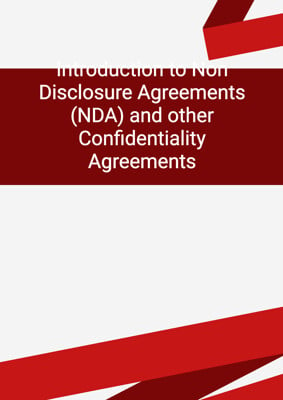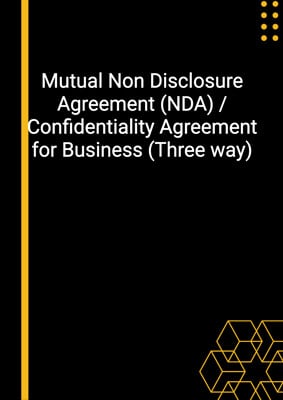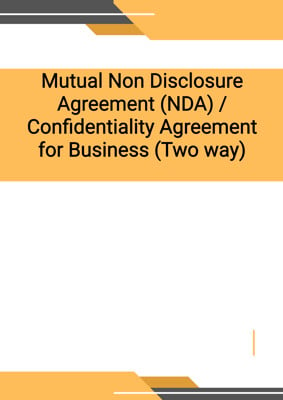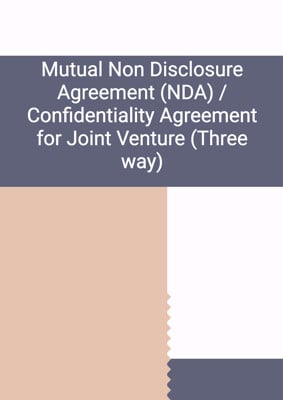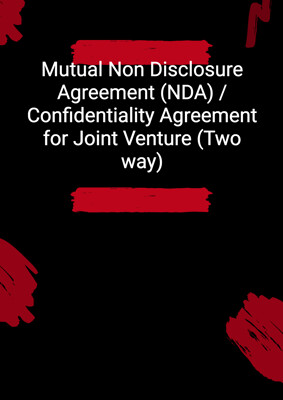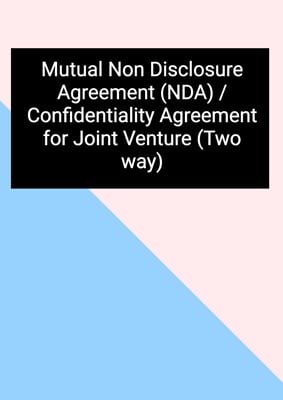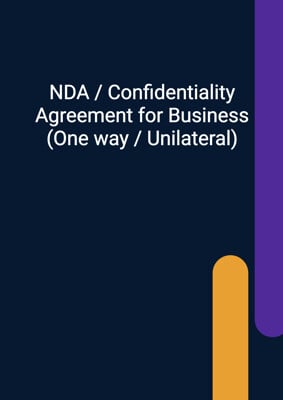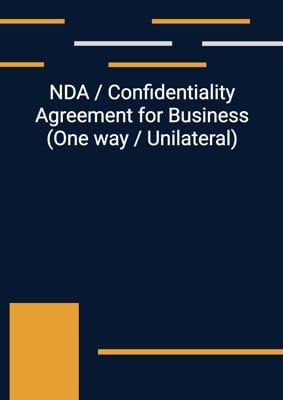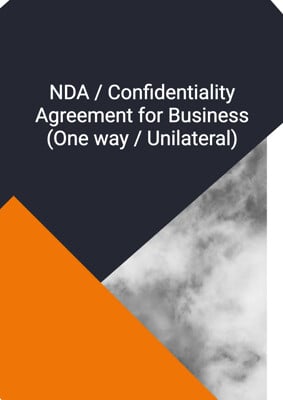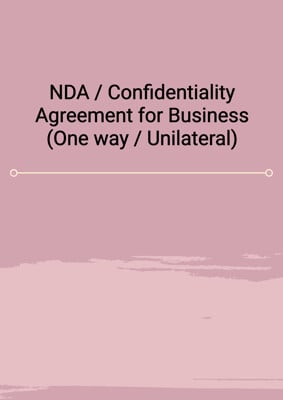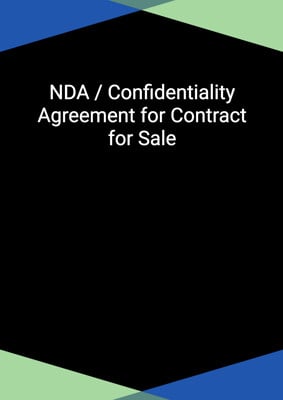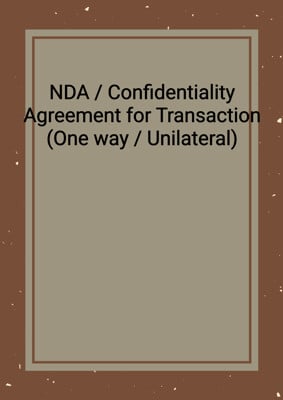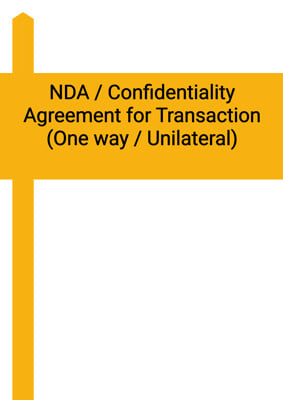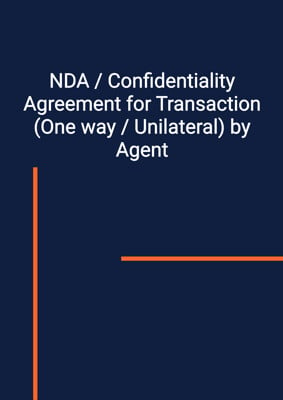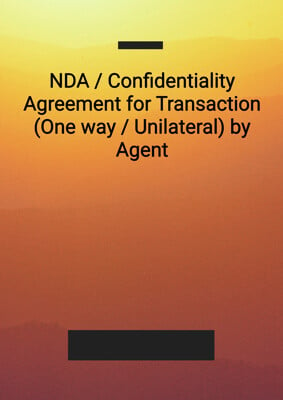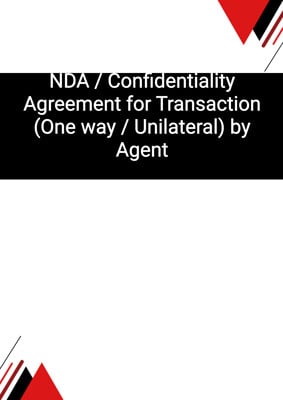
Mutual Non Disclosure Agreement (NDA) / Confidentiality Agreement for Joint Venture (Three way)
Loose / Light
Non Disclosure agreement for a basic information exchange agreement applicable where three parties are agreeing to exchange confidential information before concluding a binding joint venture agreement. It imposes a mutual obligation of confidentiality on the parties who provide and receive information at the same time. This form is looser and easier to comply with by the parties.
How to Tailor the Document for Your Need?
01
Create Document
Fill in the details of the parties. You can click the "Fill with Member’s Information" button to complete it with information saved to your account.
02
Fill Information
Please fill in any additional information by following the step-by-step guide on the left hand side of the preview document and click the "Next" button.
03
Get Document
When you are done, click the "Get Document" button and you can download the document in Word or PDF format.
04
Review Document
Please get all parties to review the document carefully and make any final modifications to ensure that the details are correct before signing the document.
Document Preview
Document Description
This document is a Mutual Non-Disclosure Agreement (NDA) or Confidentiality Agreement for a Joint Venture involving three parties. The agreement is entered into by Party 1, Party 2, and Party 3, who each have their principal place of business at their respective addresses. The purpose of this agreement is to facilitate the exchange of confidential information between the parties for the evaluation of a possible joint venture in the field of transaction between Party 1, Party 2, and Party 3.
The agreement begins with definitions of key terms used throughout the document. These definitions include Approved Representatives, Associate, Group, Holding Company, Subsidiary, Information, and Purpose. The definitions provide clarity and ensure that all parties have a common understanding of the terms used.
The obligations of confidentiality are outlined in Section 2 of the agreement. Each party undertakes to keep the information confidential and to use it exclusively for the purpose of evaluating the joint venture. The parties are prohibited from copying, reproducing, or reducing the information to writing, except as necessary for the purpose. Additionally, the parties are not allowed to use, reproduce, transform, or store the information in an externally accessible computer or electronic information retrieval system, except on a cloud-based storage platform that provides adequate protection. The parties are also restricted from transmitting the information outside of their usual place of business, except on a need-to-know basis.
Section 3 of the agreement outlines the confidentiality measures that the parties must adhere to. This includes not disclosing the information to anyone other than approved representatives who require access for the purpose and are bound by obligations of confidentiality. The parties must apply no lesser security measures to the information than they apply to their own confidential information. They must also ensure that all documents or records containing the information are kept at their premises and not removed without prior written approval.
If the information is stored within a computer system or in machine-readable form, the receiving party must ensure that it is secured to prevent unauthorized access or copying. The receiving party is responsible for enforcing the obligations of confidentiality and must do so at its own expense and at the request of the disclosing party.
The agreement also addresses exceptions to the obligations of confidentiality in Section 4. The parties are not bound by the obligations for information that is lawfully available to the public, previously known to the receiving party, disclosed by a third party with the right to do so, or independently developed by the receiving party. If either party is required to disclose the information by law or regulation, they must inform the other party and use reasonable endeavors to agree on the extent and timing of the disclosure.
Section 5 of the agreement covers the return of information. Upon written request, each party must return or destroy all documents and materials containing the information. The receiving party is not required to return or destroy reports, notes, or other material that incorporates the information, but such material remains subject to the terms of the agreement.
The agreement includes provisions for announcements, notices and service, rights under contracts for third parties, and governing law and jurisdiction. It also includes a disclaimer stating that no rights or obligations other than those expressly granted are implied from the agreement, and that no license is granted under any intellectual property rights.
The entire agreement is set out in this document, and no other representations, warranties, or undertakings are relied upon. The agreement is binding and enforceable, and the parties acknowledge that damages would not be an adequate remedy for any breach. The disclosing party is entitled to remedies such as injunction and specific performance. The agreement cannot be assigned by either party, and any assignment of rights or obligations is prohibited.
This agreement is governed by the laws of the relevant jurisdiction, and any disputes are subject to the jurisdiction of the relevant courts. Notices and service under the agreement can be delivered by hand, email, or post, and the addresses of the parties are provided.
The agreement concludes with a statement that no third party has the right to enforce any of its terms.
How to use this document?
To use this Mutual Non-Disclosure Agreement (NDA) or Confidentiality Agreement for a Joint Venture, follow these steps:
1. Review the agreement: Familiarize yourself with the terms and conditions of the agreement, including the definitions and obligations of confidentiality.
2. Fill in the parties' information: Enter the names and addresses of Party 1, Party 2, and Party 3 in the appropriate sections of the agreement.
3. Understand the purpose: Understand that the purpose of the agreement is to evaluate a possible joint venture in the field of transaction between the parties.
4. Exchange confidential information: Exchange confidential information between the parties for the purpose of evaluating the joint venture, ensuring that the information is kept confidential and used exclusively for the purpose.
5. Adhere to confidentiality measures: Keep the disclosed information confidential and apply appropriate security measures to protect it. Do not disclose the information to anyone other than approved representatives who require access for the purpose.
6. Return or destroy information: Upon written request, return or destroy all documents and materials containing the information. If applicable, secure any information stored in computer systems.
7. Comply with exceptions: Understand the exceptions to the obligations of confidentiality, such as information that is lawfully available to the public or previously known to the receiving party.
8. Seek approval for announcements: Keep the existence and nature of the agreement confidential and obtain approval from both parties for any announcements or circulars related to the agreement.
9. Understand rights and remedies: Understand that the disclosing party has rights to remedies such as injunction and specific performance in case of breach of the agreement.
10. Comply with governing law and jurisdiction: Understand that the agreement is governed by the laws of the relevant jurisdiction and any disputes are subject to the jurisdiction of the relevant courts.
11. Serve notices properly: Serve notices by hand, email, or post in accordance with the specified requirements.
12. Keep the agreement confidential: Understand that no third party has the right to enforce any of the terms of the agreement.
Note: This guidance is provided for informational purposes only and does not constitute legal advice. It is recommended to consult with legal professionals for specific legal advice related to the use of this agreement.
Not the right document?
Don’t worry, we have thousands of documents for you to choose from:




